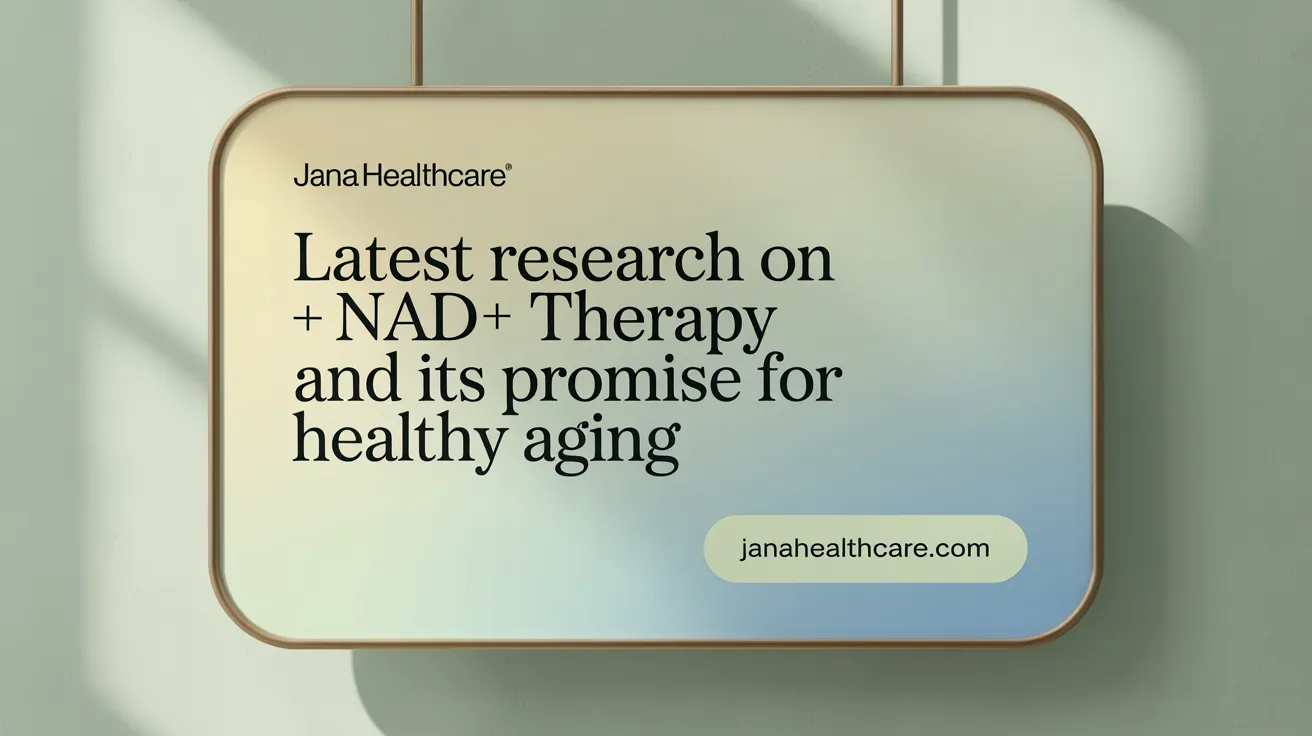Exploring the Nexus of NAD+ and Anti-Aging Science
As the quest for longevity intensifies, Nicotinamide Adenine Dinucleotide, or NAD+, has emerged as a central molecule in understanding cellular aging and rejuvenation. This article explores the biochemical foundations, current research, therapeutic potentials, and innovative strategies involving NAD+ in the context of healthy aging and age-related diseases.
NAD+: The Cellular Coenzyme at the Heart of Aging and Rejuvenation

What is NAD+ and what role does it play in cellular rejuvenation and aging?
NAD+ (nicotinamide adenine dinucleotide) is a vital coenzyme found in every living cell, fundamental for maintaining cellular health. It acts as a key player in cellular energy production, DNA repair, and cell signaling, ensuring that cells function optimally.
Biochemical importance in energy metabolism and DNA repair
NAD+ participates in redox reactions crucial for converting nutrients into energy, primarily supporting the Krebs cycle and oxidative phosphorylation. It also serves as a substrate for enzymes like sirtuins and poly(ADP-ribose) polymerases (PARPs), which facilitate vital processes such as DNA repair, epigenetic regulation, and protein maintenance.
Impact of NAD+ decline on aging
Levels of NAD+ decline significantly with age across various tissues, including the brain, skin, liver, and muscles. This decrease hampers mitochondrial efficiency, increases oxidative stress, and accelerates cellular senescence—all hallmarks of aging. A reduced NAD+ supply impairs the activity of enzymes responsible for maintaining cellular integrity, leading to tissue degeneration and heightened susceptibility to age-related diseases.
Enzymatic pathways involving NAD+ (sirtuins, PARPs)
NAD+ is essential for the function of enzymes like sirtuins, which regulate gene expression, inflammation, and metabolic processes favoring longevity. PARPs, another NAD+-dependent enzyme family, are critical for DNA repair and genomic stability.
Effect on cellular health and longevity
By activating these enzymes, NAD+ supports cellular resilience, autophagy, and overall tissue regeneration. Restoring NAD+ levels through supplements such as NMN and NR has shown promising results in animal studies—improving mitochondrial function, reducing inflammation, and delaying age-related decline.
More information search query
To explore further, searching "NAD+ role in cellular metabolism and aging" can provide extensive insights into its mechanisms and potential as an anti-aging therapeutic target.
Age-Related NAD+ Decline: Mechanisms and Cellular Consequences

How does NAD+ metabolism change with age, and what impact does this have on cellular health?
NAD+ (nicotinamide adenine dinucleotide) is vital for cellular energy production, DNA repair, and maintaining mitochondrial health. As we age, NAD+ levels decline significantly across various tissues such as the liver, skin, and blood plasma. This decrease is driven by multiple factors, including the increased activity of enzymes like CD38 and PARPs, which consume NAD+ during DNA repair and immune responses. Additionally, the body's natural biosynthesis of NAD+ slows down because of reduced activity of enzymes like NAMPT involved in the salvage pathway.
This decline directly impacts cell function by impairing vital processes. The activity of NAD+-dependent enzymes such as sirtuins, which regulate gene expression and protect against oxidative stress, diminishes. Consequently, mitochondrial function suffers, leading to decreased energy output and increased production of damaging reactive oxygen species.
Furthermore, diminished NAD+ levels compromise DNA repair mechanisms, allowing accumulation of genetic damage that accelerates cellular aging. The resulting inflammation and mitochondrial dysfunction contribute to common age-related issues like neurodegeneration, metabolic disorders, and weakened immune responses.
Interventions aiming to restore NAD+ levels—such as supplementation with precursors like NMN and NR—have shown promising results in preclinical studies. These approaches can improve mitochondrial health, enhance DNA repair, and reduce inflammation, thereby supporting healthier aging.
In summary, the age-related decline in NAD+ levels hampers critical cellular processes, promoting the aging process and increasing vulnerability to diseases. Still, researchers believe that maintaining NAD+ homeostasis is key to promoting longevity and cellular resilience.
Molecular Pathways and Processes Influenced by NAD+ in Aging

What biochemical pathways and processes are influenced by NAD+ that affect aging and cellular health?
NAD+ plays a crucial role in a variety of biochemical pathways fundamental to maintaining cellular vitality and overall health. It acts as a central coenzyme in energy metabolism, particularly in pathways like glycolysis, the citric acid cycle (TCA cycle), and oxidative phosphorylation within mitochondria. These processes are essential for converting nutrients into usable cellular energy in the form of ATP.
Beyond energy production, NAD+ is vital for DNA repair and gene regulation. It functions as a substrate for enzymes such as sirtuins (SIRTs), which deacetylate histones and other proteins, influencing gene expression, stress resistance, and mitochondrial function. Sirtuins are often linked to longevity and cellular health because they help optimize metabolic processes and protect against oxidative damage.
Another important group of NAD+-dependent enzymes are poly(ADP-ribose) polymerases (PARPs), which utilize NAD+ to facilitate DNA repair mechanisms. When DNA damage occurs—such as from UV exposure or oxidative stress—PARPs activate to help repair the damage. However, excessive activation can deplete NAD+ levels, impairing cellular functions.
Additionally, enzymes like CD38 and SARM1 use NAD+ as a substrate to regulate immune responses, inflammation, and neurodegenerative processes. In aging, increased activity of these NAD+ consumer enzymes accelerates NAD+ decline, impairing cellular resilience.
The redox capacity of NAD+ is also essential for maintaining cellular health. It participates in oxidation-reduction reactions in metabolic pathways, balancing the cellular NAD+/NADH ratio. This balance influences mitochondrial efficiency, reactive oxygen species (ROS) levels, and cellular aging (source).
As we age, NAD+ levels decrease due to heightened activity of NAD+ consuming enzymes like PARPs and CD38, coupled with reduced biosynthesis via pathways involving enzymes such as NAMPT. This decline impairs mitochondrial function, DNA repair, and epigenetic regulation, leading to increased oxidative stress, cellular senescence, and inflammation—all hallmarks of aging (more details).
To counteract these effects, strategies such as supplementation with NAD+ precursors like NMN and NR aim to restore NAD+ levels, thereby supporting genomic stability, mitochondrial health, and metabolic balance. Understanding these interconnected pathways elucidates how boosting NAD+ can potentially delay aging processes and enhance cellular resilience (read further).
Clinical Insights and Therapeutic Potential of NAD+ Supplementation

Scientific research on NAD+ therapy in aging and disease
Current scientific studies demonstrate that NAD+ levels decline progressively with age, correlating with increased vulnerability to age-related illnesses such as neurodegeneration, metabolic syndrome, and cardiovascular diseases. Laboratory experiments in cell cultures and animal models consistently show that elevating NAD+ levels through precursor supplementation (like NMN and NR) can enhance mitochondrial function, improve DNA repair, and reduce inflammation. Notably, animal studies report improvements in tissue regeneration, muscle strength, and overall vitality. In human trials, NAD+ boosters have successfully increased intracellular NAD+ concentrations and showed initial benefits like decreased inflammation and improved cellular energy. Despite these promising findings, the evidence for reversing complex age-related diseases in humans remains inconclusive, with ongoing research aiming to clarify efficacy and mechanisms. Additionally, emerging studies explore how gut microbiota influences NAD+ metabolism, revealing potential new therapeutic avenues.
Innovations in NAD+ Augmentation and Cellular Rejuvenation Techniques
 Recent advances in cellular rejuvenation have integrated NAD+ precursor supplementation with cutting-edge genetic reprogramming methods, pushing the boundaries of anti-aging therapies. Utilizing NAD+ precursors like nicotinamide mononucleotide (NMN) and nicotinamide riboside (NR), researchers aim to replenish tissue NAD+ levels, boosting the activity of vital enzymes such as sirtuins and PARPs. These enzymes are crucial for DNA repair, mitochondrial efficiency, and epigenetic regulation, which collectively promote cellular health and combat age-associated deterioration.
Recent advances in cellular rejuvenation have integrated NAD+ precursor supplementation with cutting-edge genetic reprogramming methods, pushing the boundaries of anti-aging therapies. Utilizing NAD+ precursors like nicotinamide mononucleotide (NMN) and nicotinamide riboside (NR), researchers aim to replenish tissue NAD+ levels, boosting the activity of vital enzymes such as sirtuins and PARPs. These enzymes are crucial for DNA repair, mitochondrial efficiency, and epigenetic regulation, which collectively promote cellular health and combat age-associated deterioration.
Simultaneously, novel gene editing methods—particularly partial reprogramming with Yamanaka factors (Oct4, Sox2, Klf4, c-Myc)—have shown potential to reset cellular epigenetic markers towards a youthful state without complete dedifferentiation. These approaches effectively reduce cellular senescence and enhance regenerative capacity, offering promising avenues for extending healthspan.
Combining NAD+ boosting with genetic reprogramming may create synergistic effects, fostering more profound cellular rejuvenation. Ongoing research indicates that higher NAD+ levels can influence epigenetic modifications, thereby supporting the reprogramming process and restoring youthful gene expression patterns.
Looking forward, studies are increasingly focusing on how to optimize these combination therapies, including delivery methods, dosing, and timing. As understanding deepens, these innovations could substantially alter the future landscape of longevity and age reversal treatments, making cellular rejuvenation both more effective and accessible.
Harnessing NAD+ for Future Anti-Aging Therapies
NAD+ stands at the forefront of anti-aging research, bridging the gap between cellular metabolism, DNA repair, and longevity. Despite the natural decline of NAD+ with age posing challenges to cellular health, emerging therapies and supplementation strategies offer promising avenues to restore its levels and function. Current research, while still evolving, underscores the potential of NAD+ therapy to combat age-associated diseases, enhance mitochondrial efficiency, and promote systemic rejuvenation. Coupled with breakthroughs in genetic reprogramming and epigenetic modulation, NAD+ augmentation embodies a multifaceted approach to slowing, halting, or even reversing aspects of biological aging. Continued rigorous clinical trials and mechanistic studies will be pivotal in translating these scientific advances into safe, effective interventions, ultimately enabling healthier aging and extended human healthspan.
